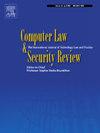The future of the movie industry in the wake of generative AI: A perspective under EU and UK copyright law
IF 3.2
3区 社会学
Q1 LAW
引用次数: 0
Abstract
Like all sectors, the movie industry has been both affected by and exploring potential uses of generative Artificial Intelligence ('AI'). On the one hand, movie studios have detected and begun to add warnings against unlicensed third-party uses of their content, including for AI training,1 and have taken enforcement initiatives through court action. On the other hand, the use of AI within and by the industry itself has been growing. Regarding the latter, some have emphasised the opportunities presented by the implementation of AI, including by advancing claims that AI tools can offer a `purer' form of expression. Others have instead warned against the potential displacement of industry workers, including workers employed in technical roles and younger and emerging actors.
Against the background illustrated above, this study maps and critically evaluates relevant issues facing the development, deployment, and use of AI models from a movie industry perspective. The legal analysis is conducted having regard to EU and UK copyright law and is divided into three parts:
- •Input/AI training: By considering relevant legal restrictions applicable to the training of AI models on protected audiovisual content, the border between lawful unlicensed uses and restricted uses is drawn;
- •Protectability of AI-generated outputs: Turning to the output generation phase, the protectability of such outputs is considered next, by focusing in particular on the requirements of authorship and originality under EU and UK copyright law;
- •Legal risks and potential liability stemming from the use of third-party AI models for output generation: Still having regard to the output generation phase, relevant legal issues that might arise having regard to the use of AI models that `regurgitate' third-party training data at output generation are considered, alongside the question of style protection under copyright.
The main conclusions are as follows:
- •Input/AI training: Insofar as model training on third-party protected content is concerned, there are no exceptions under EU/UK law that fully cover the entirety of these processes. As a result, lacking legislative reform, the establishment of a licensing framework appears unavoidable for such activities to be deemed lawful;
- •Protectability of AI-generated outputs: The deployment of AI across various phases of the creative process does not render the resulting content unprotectable, provided that human involvement and control remain significant throughout, with the result that AI is relied upon as a tool that aids – rather than replaces – the creativity of industry workers.
- •Legal risks and potential liability stemming from the use of third-party AI models for output generation: The use of AI models that generate infringing outputs, such as by regurgitating input data or merely imitating style, may trigger the application of exclusive rights under copyright and related rights. The resulting liability may vest with the user of such models, as well as the model developer/provider. The latter aspect means that terms that exclude any such liability may ultimately be found to be unenforceable against users and ineffective against rightholders.
生成式人工智能之后电影业的未来:欧盟和英国版权法下的视角
与所有行业一样,电影行业也受到了生成式人工智能(“AI”)的影响,并在探索其潜在用途。一方面,电影制片厂已经发现并开始对未经许可的第三方使用其内容(包括人工智能培训)增加警告,并通过法院诉讼采取了强制措施。另一方面,人工智能在行业内部和行业本身的使用一直在增长。关于后者,一些人强调了人工智能的实施所带来的机会,包括声称人工智能工具可以提供“更纯粹”的表达形式。另一些人则警告说,工业工人可能会被取代,包括从事技术工作的工人,以及更年轻和新兴的工人。在上述背景下,本研究从电影行业的角度绘制并批判性地评估了开发、部署和使用人工智能模型所面临的相关问题。法律分析是根据欧盟和英国版权法进行的,分为三个部分:•输入/人工智能训练:通过考虑适用于人工智能模型在受保护的视听内容上进行训练的相关法律限制,划定合法的未经许可的使用和受限制的使用之间的边界;•人工智能生成输出的可保护性:转向输出生成阶段,接下来将考虑此类输出的可保护性,特别关注欧盟和英国版权法下的作者身份和原创性要求;•使用第三方人工智能模型进行输出生成所产生的法律风险和潜在责任:仍然考虑到输出生成阶段,在输出生成时使用“反哺”第三方训练数据的人工智能模型可能产生的相关法律问题,以及版权下的风格保护问题。主要结论如下:•输入/人工智能培训:就第三方受保护内容的模型培训而言,在欧盟/英国法律下没有例外,完全涵盖了所有这些过程。结果,由于缺乏立法改革,为使这些活动被视为合法,似乎不可避免地要建立一个许可框架;•人工智能生成输出的可保护性:在创作过程的各个阶段部署人工智能并不会使最终的内容无法保护,前提是人类的参与和控制在整个过程中仍然很重要,结果是人工智能被依赖为辅助工具,而不是取代行业工人的创造力。•使用第三方AI模型生成输出所产生的法律风险和潜在责任:使用产生侵权输出的AI模型,例如通过重复输入数据或仅仅模仿风格,可能会触发版权和相关权利下的专有权的应用。由此产生的责任可能归属于这些模型的用户,以及模型开发人员/提供者。后一个方面意味着排除任何此类责任的条款最终可能被发现对用户不可执行,对权利人无效。
本文章由计算机程序翻译,如有差异,请以英文原文为准。
求助全文
约1分钟内获得全文
求助全文
来源期刊
CiteScore
5.60
自引率
10.30%
发文量
81
审稿时长
67 days
期刊介绍:
CLSR publishes refereed academic and practitioner papers on topics such as Web 2.0, IT security, Identity management, ID cards, RFID, interference with privacy, Internet law, telecoms regulation, online broadcasting, intellectual property, software law, e-commerce, outsourcing, data protection, EU policy, freedom of information, computer security and many other topics. In addition it provides a regular update on European Union developments, national news from more than 20 jurisdictions in both Europe and the Pacific Rim. It is looking for papers within the subject area that display good quality legal analysis and new lines of legal thought or policy development that go beyond mere description of the subject area, however accurate that may be.

 求助内容:
求助内容: 应助结果提醒方式:
应助结果提醒方式:


